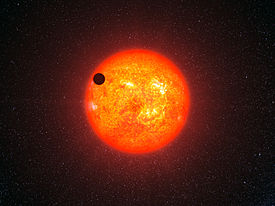GJ 1214b was discovered in December 2009 and is an Ocean Planet which orbits its sun GJ 1214b. What we mean by “Ocean Planet” is that it is consistent of only water- an endless ocean. For this reason, Scientists have labelled this planet “the Waterworld”.
It has a thick layer of solid ice core. The water near it’s core is under so much immense pressure from the surface that the water immediately above the core has been compressed into solid ice. This is a special form of ice know to scientists as Ice VII.
It is a “Super Earth” meaning that it is larger than earth but is smaller in mass and radius than the gas giants of the Solar System. It’s parent star is relatively near the sun and because it crosses in front of that parent star, the planets atmosphere can be studied using spectroscopic technologies. In december 2013, clouds were detected on the planet.

The radius of GJ 1214 b can be inferred from the amount of dimming seen when the planet crosses in front of its parent star as viewed from Earth. The mass of the planet can be inferred from sensitive observations of the parent star’s radial velocity, measured through small shifts in stellar spectral lines due to the Doppler effect. Given the planet’s mass and radius, its density can be calculated. Through a comparison with theoretical models, the density in turn provides limited but highly useful information about the composition and structure of the planet.

